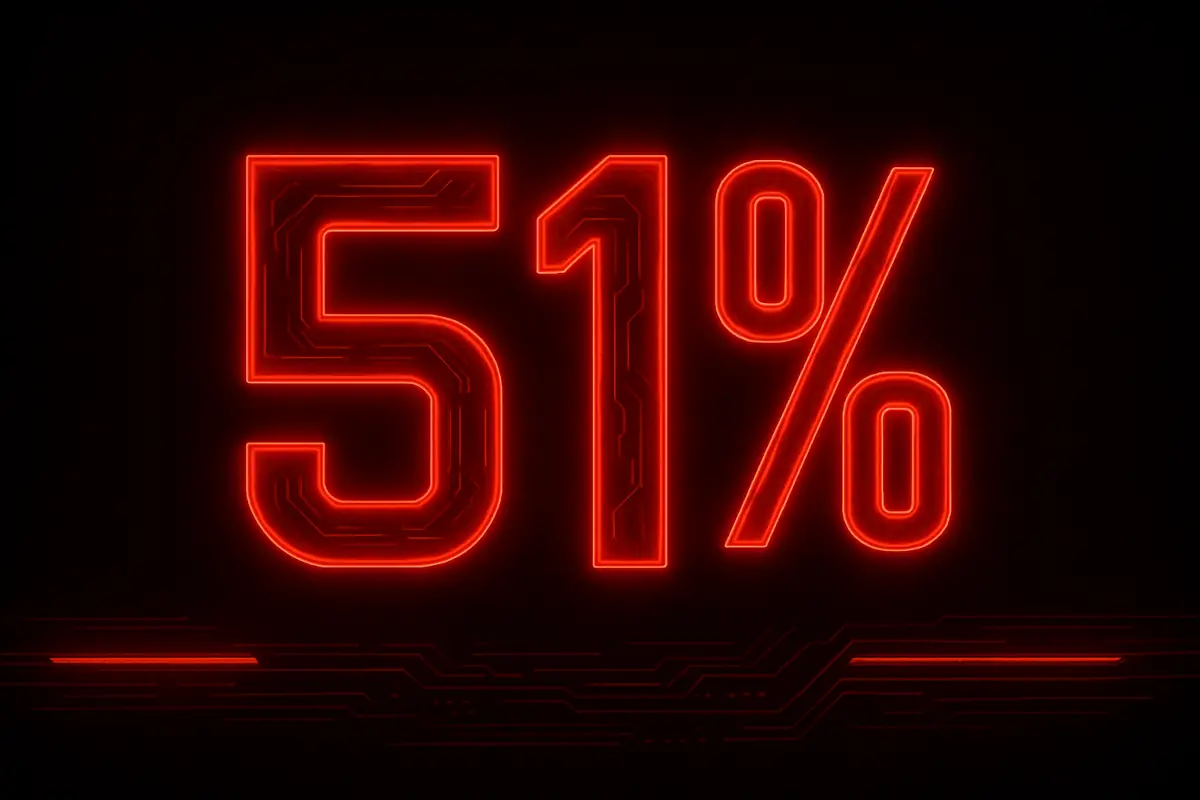A 51% attack poses a significant risk to blockchain networks, threatening the integrity and security of digital currencies. This attack occurs when a malicious entity controls more than half of a blockchain’s computational or staking power.
It can lead to various malicious outcomes, such as double-spending, transaction censorship, and even rewriting transaction history. The question arises whether major cryptocurrencies like Bitcoin and Ethereum, with their large networks, are vulnerable to such attacks, and which types of coins are at a higher risk.
Table of Contents
What Is a 51% Attack?
A 51% attack happens when a single miner or group controls more than half of a blockchain’s mining power or staked tokens. This majority control lets them override the network’s rules. They can reverse transactions, stop new ones from being confirmed, or even rewrite parts of the blockchain’s history.
The attack directly contradicts blockchain’s core principle – decentralization. Instead of a trustless system where no single party has control, a 51% attack centralizes power in the hands of an attacker. The most immediate danger is double-spending, where the same coins are used twice, undermining trust in the currency.
Smaller networks using Proof-of-Work (PoW) or Proof-of-Stake (PoS) are the most frequent targets. Larger networks like Bitcoin and Ethereum have defenses that make such attacks nearly impossible, but less secure alternatives remain at risk.
How Does a 51% Attack Work?
Blockchains rely on a distributed network of nodes to verify transactions. In PoW systems, miners compete to solve complex puzzles, and the first to succeed adds a new block. If one entity controls most of the mining power, it dictates which transactions are valid.
Attackers can create a private chain where they exclude certain transactions – like payments they made – while continuing to spend the same coins elsewhere. Once their private chain is longer than the real one, they release it, forcing the network to accept their version. This erases legitimate transactions and enables fraud.
In PoS systems, attackers need to control 51% of staked tokens rather than computing power. If they succeed, they can approve fake transactions or block legitimate ones. However, PoS networks often have slashing mechanisms, where malicious validators lose their staked funds, making attacks costly.
Read also: From a Zip File to Catastrophe: Radiant’s $50M Hack Explained
Is Bitcoin Safe from 51% Attacks?
Bitcoin’s massive hash rate – the total computing power securing it – makes a 51% attack extremely difficult. In 2014, mining pool GHash.io briefly exceeded 50% control, raising alarms. The community responded by decentralizing mining power further, ensuring no single entity could dominate. Today, attacking Bitcoin would require billions in hardware and energy costs, making it economically unfeasible.
Is Ethereum Safe from 51% Attacks?
Ethereum moved from PoW to PoS in 2022, changing how security works. Now, attackers would need to control 51% of staked ETH, which is currently over 16 million ETH (worth around $49 billion). Additionally, validators caught attacking the network face slashing, losing their staked funds. This makes large-scale attacks both expensive and risky.
While Ethereum and Bitcoin are well-protected, smaller PoW coins remain vulnerable. Networks like Ethereum Classic have suffered multiple 51% attacks, proving that security depends heavily on network size and decentralization.
Which Cryptocurrencies Are Most Vulnerable?
Smaller PoW-based coins with low hash rates are prime targets. Attackers can rent mining power cheaply to overwhelm these networks. Some notable examples:
- Bitcoin Gold (BTG) – In 2018, attackers double-spent $18 million by exploiting its weak mining security.
- Ethereum Classic (ETC) – Faced three 51% attacks in 2020, with over $5 million lost in the largest incident.
- Vertcoin (VTC) – Suffered multiple attacks in 2018 and 2019 due to its small network size.
- Firo (formerly Zcoin) – A 2021 attack is another example on how low-hash-rate chains can be manipulated.
Coins with low market value and centralized mining pools are especially at risk.
Read also: Polyhedra Releases Post-Mortem on ZKJ Collapse
How Can Blockchains Prevent 51% Attacks?
There are few things than blockchains can do to prevent 51% attacks or make them more difficult and expensive:
- Networks must avoid mining pool dominance. Encouraging more independent miners or validators spreads control, reducing attack risks.
- Some blockchains (like Solana) combine PoW and PoS, forcing attackers to control both mining power and staked tokens, raising the difficulty.
- AI-driven tools can detect sudden hash rate spikes or unusual transaction patterns, allowing quick responses before attacks escalate.
- PoS networks use slashing to punish malicious actors. Increasing penalties makes attacks financially unviable.
Read also: How Bybit Lost $1.4 Billion in Sophisticated Phishing Attack




